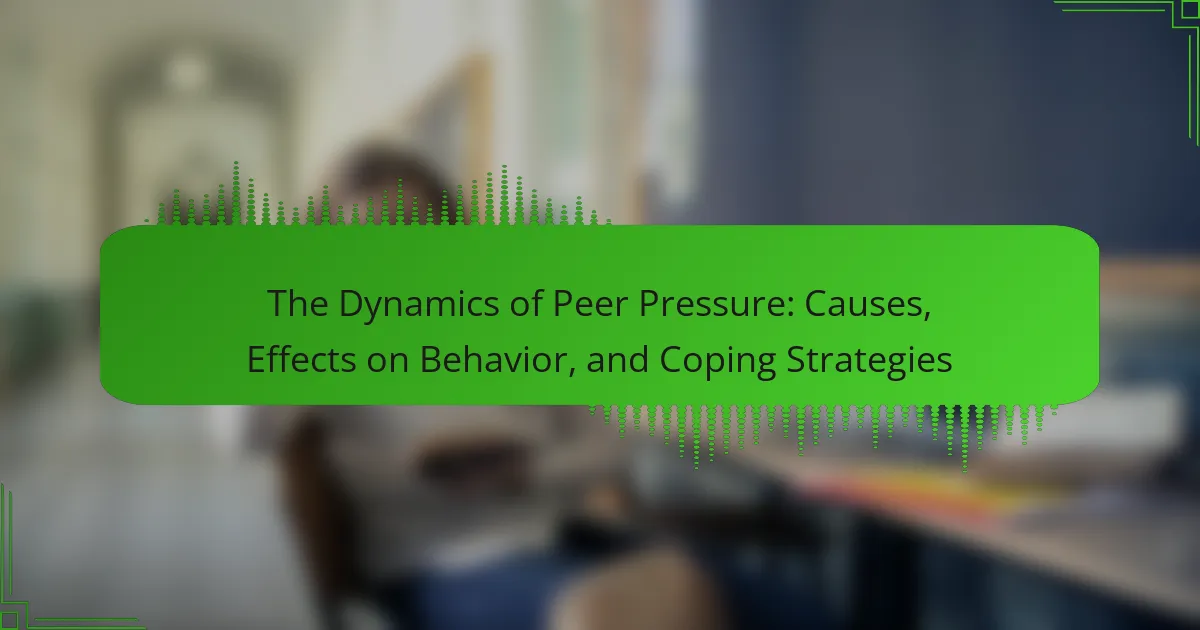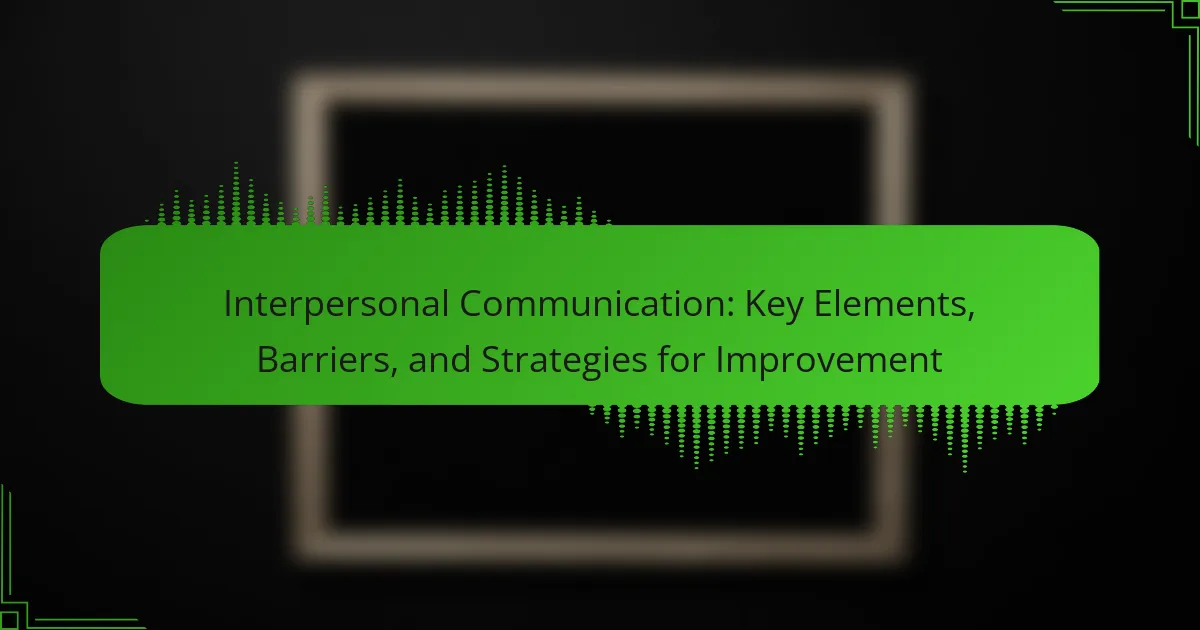Peer pressure is the influence exerted by a peer group on its members to conform to group norms, particularly affecting adolescents and young adults. This article explores the dual nature of peer pressure, highlighting both its positive aspects, such as encouraging healthy behaviors, and its negative consequences, like promoting risky activities. It examines how peer pressure significantly impacts decision-making processes during formative years and discusses effective coping strategies, including assertiveness training and developing a strong sense of self-identity. The article provides insights into managing peer influence and emphasizes the importance of self-esteem and decision-making skills in resisting negative peer pressure.
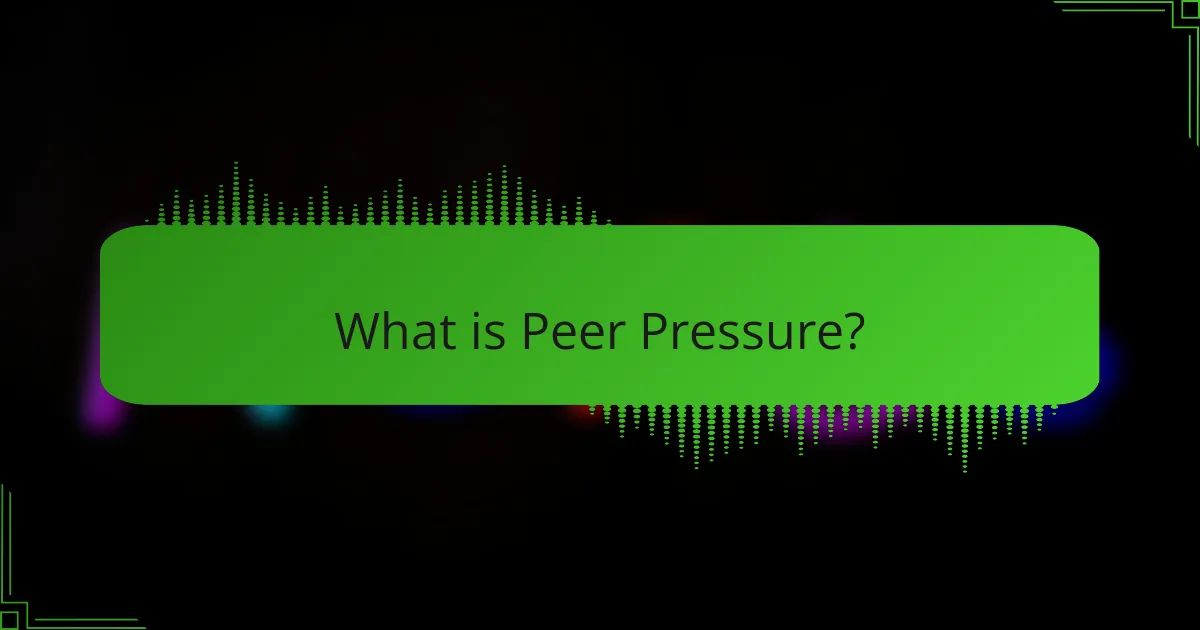
What is Peer Pressure?
Peer pressure is the influence exerted by a peer group on its members to behave in ways that conform to group norms. This phenomenon often occurs among adolescents and young adults. It can lead individuals to adopt behaviors they might not typically choose. Peer pressure can manifest in both positive and negative ways. Positive peer pressure encourages healthy behaviors, like studying or participating in sports. Negative peer pressure may lead to risky activities, such as substance abuse. Research indicates that peer pressure significantly affects decision-making processes during formative years. Studies show that about 70% of teenagers report experiencing peer pressure at some point.
How does peer pressure manifest in different social groups?
Peer pressure manifests in different social groups through various behaviors and expectations. In adolescent groups, it often leads to conformity in dress, language, and activities. For example, teenagers may feel compelled to engage in risky behaviors, such as substance use, to fit in. In academic settings, peer pressure can drive students to compete for grades or participate in group projects, influencing their study habits. In professional environments, colleagues may pressure each other to meet performance standards or adopt certain workplace norms. Research shows that individuals often change their behavior to align with group expectations, highlighting the powerful influence of social dynamics.
What are the common scenarios where peer pressure occurs?
Peer pressure commonly occurs in social settings such as schools, parties, and sports teams. In schools, students may feel pressured to conform to behaviors like skipping class or engaging in substance use. At parties, individuals might be influenced to drink alcohol or try drugs to fit in. Sports teams often create pressure to perform at high levels or engage in risky behavior for team bonding. Peer pressure can also arise in online environments, where social media may lead to comparisons and the desire to gain likes or followers. These scenarios highlight how peer pressure can manifest in various contexts, influencing individual choices and behaviors.
How do age and cultural factors influence peer pressure?
Age and cultural factors significantly influence peer pressure. Younger individuals are often more susceptible to peer pressure due to their developmental stage. Adolescents seek acceptance and approval from their peers, which can lead to conforming behaviors. Cultural context further shapes how peer pressure manifests. In collectivist cultures, the emphasis on group harmony can intensify peer pressure. Conversely, individualistic cultures may promote personal choice, leading to different peer dynamics. Research indicates that peer influence peaks during adolescence, with 80% of teens reporting experiences of peer pressure. Cultural norms dictate acceptable behaviors, impacting the intensity and type of peer pressure experienced.
What are the underlying causes of peer pressure?
Peer pressure arises from social influences among individuals in a group. It is often driven by the desire for acceptance and belonging. Adolescents are particularly susceptible due to their developmental stage. The need for approval can lead individuals to conform to group norms. Additionally, cultural and societal expectations play a significant role. Media portrayal of peer interactions can amplify these pressures. Research indicates that peer dynamics can significantly influence decision-making. A study by Steinberg and Monahan (2007) found that adolescents are more likely to engage in risky behavior when in groups.
How do individual personality traits contribute to susceptibility?
Individual personality traits significantly influence susceptibility to peer pressure. Traits such as high agreeableness and low self-esteem increase vulnerability. Agreeable individuals often seek social acceptance, making them more likely to conform. Low self-esteem can lead to a desire for approval, heightening susceptibility to external influences. Research shows that individuals with high extraversion may also be more susceptible due to their inclination towards social interactions. Conversely, those with high conscientiousness tend to resist peer pressure, valuing personal standards over group norms. This relationship between personality traits and susceptibility is supported by studies indicating that personality assessments correlate with behavioral responses to peer pressure.
What role do social dynamics play in creating peer pressure?
Social dynamics significantly influence the creation of peer pressure. They involve the interactions and relationships among individuals within a group. These dynamics can establish norms that dictate acceptable behaviors. When individuals seek acceptance, they may conform to these group norms. The desire for social approval often leads to pressure to engage in certain actions. Research indicates that adolescents are particularly susceptible to these influences. A study by Steinberg and Monahan (2007) found that peer presence increases risk-taking behavior. Thus, social dynamics play a crucial role in shaping peer pressure through established norms and the pursuit of acceptance.
Why do individuals succumb to peer pressure?
Individuals succumb to peer pressure due to a desire for acceptance and belonging. This need can drive individuals to conform to group norms. People often fear rejection or isolation from their peers. Research indicates that adolescents are particularly susceptible to peer influence. A study by Steinberg and Monahan (2007) found that teenagers are more likely to engage in risky behaviors when with peers. The influence of peers can override personal beliefs or values. Additionally, social dynamics can create a strong urge to fit in. The pressure to conform can lead to decisions that individuals might not make independently.
What psychological factors drive conformity among peers?
Conformity among peers is driven by several psychological factors. Social influence plays a key role, as individuals often adjust their behavior to align with group norms. This desire for acceptance stems from the fear of rejection or isolation. Additionally, informational social influence affects conformity. People may conform because they believe others possess more accurate information. The need for belonging also drives conformity, as social connections are vital for emotional well-being. Research indicates that group dynamics, such as cohesiveness and group size, can amplify these psychological factors. For instance, studies show that larger groups tend to exert more pressure to conform.
How does the desire for acceptance influence behavior?
The desire for acceptance significantly influences behavior by driving individuals to conform to social norms. This need for belonging can result in changes to one’s actions, beliefs, and values. For example, individuals may adopt behaviors that align with their peer group to gain approval. Research shows that adolescents are particularly susceptible to peer pressure, as they often prioritize acceptance over personal preferences. A study published in the journal “Developmental Psychology” by Steinberg and Monahan found that adolescents are more likely to engage in risky behaviors when they are with peers compared to when they are alone. This highlights how the desire for acceptance can lead to decisions that may not align with one’s values.
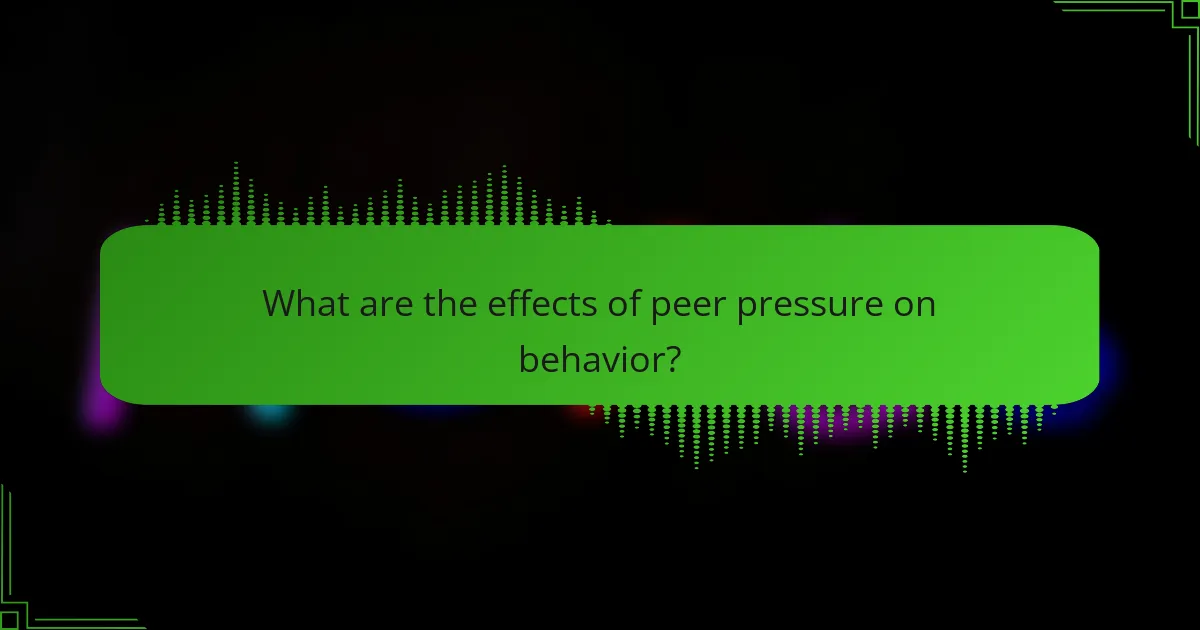
What are the effects of peer pressure on behavior?
Peer pressure significantly influences behavior by encouraging individuals to conform to group norms. This can lead to both positive and negative outcomes. Positive peer pressure can motivate individuals to engage in healthy behaviors, such as studying or participating in sports. Conversely, negative peer pressure may prompt risky behaviors, including substance abuse or delinquency. Research indicates that adolescents are particularly susceptible to peer influence due to their developmental stage. A study by Steinberg and Monahan (2007) found that peer presence increases risk-taking behavior in teenagers. Overall, peer pressure shapes individual choices and social interactions, impacting behavior across various contexts.
How does peer pressure impact decision-making?
Peer pressure significantly influences decision-making by altering individual choices to align with group norms. This social influence often leads individuals to make decisions they might not consider independently. Research indicates that adolescents are particularly susceptible to peer pressure, which can result in risky behaviors. Studies show that 70% of teens report feeling pressured to engage in activities like substance use due to peer influence. The desire for acceptance and fear of rejection can override personal values. Consequently, individuals may prioritize group approval over their own judgment. This phenomenon highlights the powerful role of social dynamics in shaping decisions.
What are the short-term effects of yielding to peer pressure?
Yielding to peer pressure can lead to immediate changes in behavior and emotional state. Individuals may engage in activities they normally would avoid, such as substance use or risky behaviors. This shift often results in feelings of guilt or regret shortly after the action. Additionally, social acceptance may temporarily increase, creating a false sense of belonging.
Research shows that adolescents are particularly susceptible to these influences, as their brains are still developing. A study published in the journal “Developmental Psychology” found that peer pressure significantly affects decision-making in youth. The pressure can also lead to stress and anxiety, as individuals struggle between personal values and the desire to conform.
What are the long-term consequences of peer pressure on individuals?
Long-term consequences of peer pressure on individuals include mental health issues, altered self-esteem, and risky behaviors. Individuals may experience anxiety and depression due to the pressure to conform. This can lead to a negative self-image and decreased self-worth over time. Additionally, individuals may engage in substance abuse or other dangerous activities as a result of peer influence. Research indicates that adolescents exposed to peer pressure are more likely to develop these issues in adulthood. A study published in the Journal of Adolescent Health found that peer pressure significantly correlates with long-term mental health outcomes.
How does peer pressure affect mental health?
Peer pressure significantly impacts mental health by influencing individuals’ thoughts, feelings, and behaviors. It can lead to increased anxiety, depression, and low self-esteem. According to a study published in the Journal of Adolescence, adolescents exposed to negative peer pressure are more likely to experience mental health issues. This pressure can create a sense of belonging or exclusion, affecting emotional well-being. Furthermore, the American Psychological Association notes that peer pressure can drive risky behaviors, further exacerbating mental health problems. Engaging in behaviors to fit in can lead to regret and shame, compounding stress.
What are the emotional repercussions of negative peer pressure?
Negative peer pressure can lead to significant emotional repercussions. Individuals often experience feelings of anxiety and stress when succumbing to negative influences. This pressure can result in low self-esteem as individuals may feel inadequate for not meeting peer expectations. Depression is another common consequence, as the struggle between personal values and peer demands can create internal conflict. Additionally, feelings of isolation may arise when individuals distance themselves from supportive relationships. Research indicates that adolescents facing negative peer pressure are more likely to report emotional distress (Steinberg & Monahan, 2007). This emotional turmoil can have lasting effects on mental health and well-being.
How can positive peer pressure contribute to personal growth?
Positive peer pressure can significantly contribute to personal growth by encouraging individuals to adopt healthier behaviors and pursue goals. When surrounded by peers who value education, fitness, or positive social interactions, individuals are more likely to emulate these behaviors. This influence can lead to improved academic performance, increased physical activity, and enhanced social skills. Research shows that adolescents who engage with positive peer groups are more likely to develop resilience and self-esteem. A study published in the Journal of Youth and Adolescence found that supportive peer relationships correlate with better mental health outcomes. Thus, positive peer pressure acts as a catalyst for personal growth by fostering an environment that promotes constructive choices and personal development.
What behaviors are commonly influenced by peer pressure?
Peer pressure commonly influences behaviors such as substance use, risk-taking, and social conformity. Adolescents may start smoking or drinking alcohol due to peer influence. They often engage in risky activities like reckless driving or unsafe [censured] practices to fit in. Social conformity can lead individuals to adopt specific fashion trends or use particular slang. Research shows that 70% of teens report feeling pressured to engage in risky behaviors by their peers. This highlights the significant impact of peer dynamics on decision-making during formative years.
What risky behaviors are associated with negative peer pressure?
Risky behaviors associated with negative peer pressure include substance abuse, delinquency, and risky [censured] activities. Substance abuse often involves alcohol and drug use, which can lead to addiction and health issues. Delinquency may manifest as vandalism, theft, or truancy, resulting in legal consequences. Risky [censured] activities can include unprotected [censured], increasing the risk of sexually transmitted infections and unintended pregnancies. Research indicates that adolescents are more likely to engage in these behaviors when influenced by peers, highlighting the significant impact of social dynamics on decision-making.
How can peer pressure lead to positive lifestyle choices?
Peer pressure can lead to positive lifestyle choices by encouraging individuals to adopt healthier behaviors. When friends or peers engage in activities like exercising or eating nutritious foods, others may feel motivated to join. This social influence can create a supportive environment for making better choices. Research shows that individuals are more likely to participate in physical activities when encouraged by their peers. A study published in the Journal of Health Psychology found that peer support significantly increases exercise adherence among young adults. Positive peer pressure can also foster a sense of accountability, making individuals more likely to stick to their commitments.
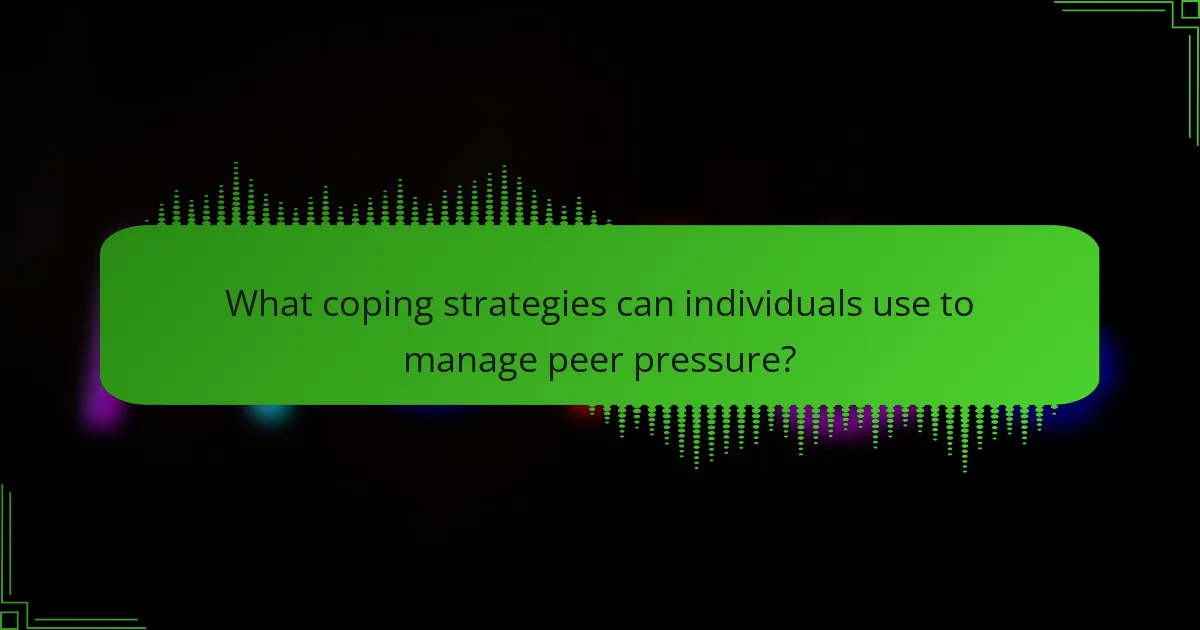
What coping strategies can individuals use to manage peer pressure?
Individuals can manage peer pressure by employing several coping strategies. One effective strategy is assertiveness training. This helps individuals communicate their thoughts and feelings confidently. Another strategy is developing a strong sense of self-identity. When individuals know their values, they are less likely to succumb to external influences.
Additionally, seeking support from trusted friends or family can provide necessary encouragement. Engaging in activities that promote self-esteem can also help. Studies show that individuals with higher self-esteem are better equipped to resist peer pressure.
Practicing decision-making skills enables individuals to evaluate situations critically. Setting clear personal boundaries is crucial as well. Those who establish limits are more likely to stand firm against peer influence.
How can individuals build resilience against peer pressure?
Individuals can build resilience against peer pressure by developing strong self-identity and assertiveness skills. A clear understanding of personal values helps individuals resist negative influences. Practicing decision-making skills enhances confidence in choosing the right path. Role-playing scenarios can prepare individuals for real-life situations involving peer pressure. Support from friends and family provides a safety net against external pressures. Engaging in activities that promote self-esteem fosters a positive self-image. Research shows that adolescents with strong social networks are less likely to succumb to peer pressure. According to a study by Steinberg and Monahan (2007), social connectedness significantly reduces susceptibility to peer influence.
What role does self-esteem play in resisting peer influence?
Self-esteem plays a crucial role in resisting peer influence. Individuals with high self-esteem are more confident in their decisions. This confidence enables them to stand firm against peer pressure. Research indicates that high self-esteem is linked to better decision-making skills. For example, a study by Brown and McIlroy (2019) found that adolescents with higher self-esteem were less likely to engage in risky behaviors due to peer pressure. Conversely, low self-esteem can make individuals more susceptible to conforming to peers. Thus, fostering self-esteem can be an effective strategy in helping individuals resist negative peer influence.
How can effective communication skills help in managing peer pressure?
Effective communication skills empower individuals to resist peer pressure. These skills foster assertiveness, enabling clear expression of thoughts and feelings. Assertive communication helps individuals set boundaries with peers. It allows them to articulate their choices without fear of judgment. Moreover, effective communication enhances active listening. This skill facilitates understanding others’ perspectives and reduces conflict. By engaging in open dialogue, individuals can negotiate situations involving peer pressure. Research shows that adolescents with strong communication skills are more likely to make independent decisions. This independence is crucial for resisting negative influences. Thus, effective communication significantly aids in managing peer pressure.
What practical strategies can help in coping with peer pressure?
Developing assertiveness is a practical strategy for coping with peer pressure. Assertiveness allows individuals to express their feelings and opinions confidently. This can be practiced through role-playing scenarios where one must say “no” to peer pressure. Establishing personal values also aids in resisting negative influences. Knowing what one stands for strengthens decision-making.
Building a supportive network of friends is crucial. Positive friendships provide encouragement and reduce feelings of isolation. Engaging in activities that align with personal interests helps reinforce self-identity. Additionally, practicing mindfulness can help individuals manage stress related to peer pressure. Techniques such as deep breathing or meditation can enhance emotional regulation.
Setting clear boundaries is essential in social situations. This involves communicating limits to peers regarding acceptable behavior. Seeking guidance from trusted adults can also provide valuable perspectives. Research indicates that individuals with strong coping strategies are less likely to succumb to peer pressure. A study by Steinberg and Monahan (2007) found that adolescents with positive peer relationships experience lower levels of pressure.
How can setting personal boundaries assist in resisting peer pressure?
Setting personal boundaries helps individuals resist peer pressure by establishing clear limits on acceptable behavior. These boundaries empower individuals to assert their values and choices confidently. When someone knows their limits, they are less likely to be swayed by others’ opinions or actions. Research indicates that individuals with strong personal boundaries report higher self-esteem and better decision-making skills. A study published in the Journal of Adolescence found that teens who practiced boundary-setting were more likely to refuse risky behaviors. This demonstrates that personal boundaries serve as a protective factor against negative influences.
What are some techniques for making independent choices?
Techniques for making independent choices include self-reflection, critical thinking, and setting personal values. Self-reflection helps individuals understand their preferences and motivations. Critical thinking encourages evaluating options and considering consequences. Setting personal values provides a framework for decision-making aligned with one’s beliefs. Research shows that individuals who engage in these techniques are more likely to make choices that reflect their true selves. This empowerment can reduce the influence of peer pressure.
What resources are available for those struggling with peer pressure?
Support groups are available for those struggling with peer pressure. These groups provide a safe space for individuals to share experiences. Professional counseling services also offer guidance and coping strategies. Many schools have counselors trained to assist students with peer-related issues. Online resources, such as forums and websites, provide advice and community support. Educational workshops focus on building resilience against peer influence. Hotlines are available for immediate support and advice. Research shows that connecting with others can reduce feelings of isolation and anxiety related to peer pressure.
How can support groups or counseling provide assistance?
Support groups or counseling can provide assistance by offering emotional support and a safe space for sharing experiences. They facilitate connections among individuals facing similar challenges. This interaction can reduce feelings of isolation and promote a sense of belonging. Counselors can provide professional guidance and coping strategies tailored to individual needs. Research indicates that participants in support groups report improved mental health outcomes. A study published in the Journal of Counseling Psychology found that group therapy can significantly reduce symptoms of anxiety and depression. This evidence supports the effectiveness of support groups and counseling in providing meaningful assistance.
What role do educational programs play in addressing peer pressure?
Educational programs play a crucial role in addressing peer pressure. They provide students with knowledge and skills to recognize and resist negative influences. These programs often include workshops and interactive sessions that facilitate discussions about peer dynamics. They educate students on the consequences of succumbing to peer pressure. Research shows that students who participate in these programs demonstrate improved decision-making skills. Programs also promote self-esteem and assertiveness, which are vital in resisting peer pressure. Evidence indicates that schools implementing such programs see a reduction in risky behaviors among students. Overall, educational programs empower youth to navigate social pressures effectively.
Peer pressure is the influence exerted by a peer group on its members to conform to group norms, significantly impacting behavior, particularly among adolescents. This article explores the causes and effects of peer pressure, detailing how it manifests in various social contexts, including schools and online environments. It examines the psychological factors driving conformity, the emotional repercussions of negative peer pressure, and the potential for positive peer influence to foster personal growth. Additionally, the article outlines coping strategies and resources for individuals to manage peer pressure effectively.
